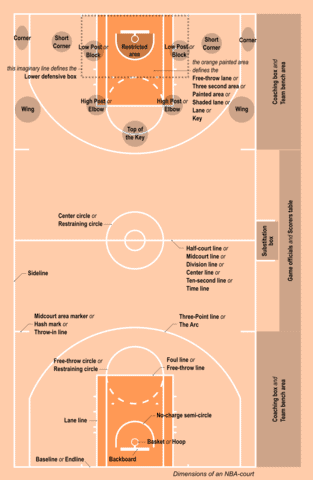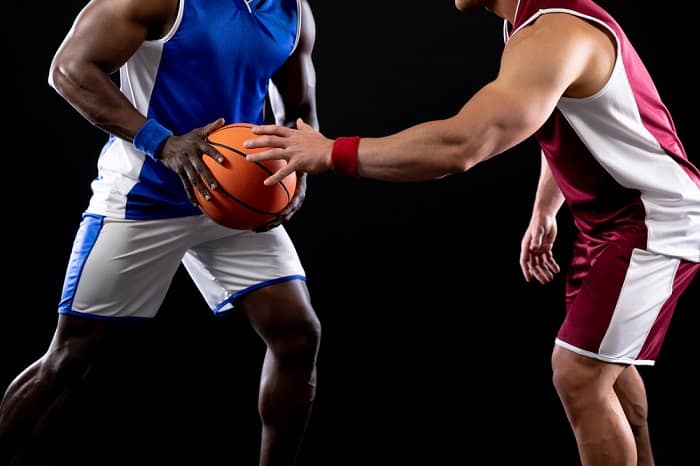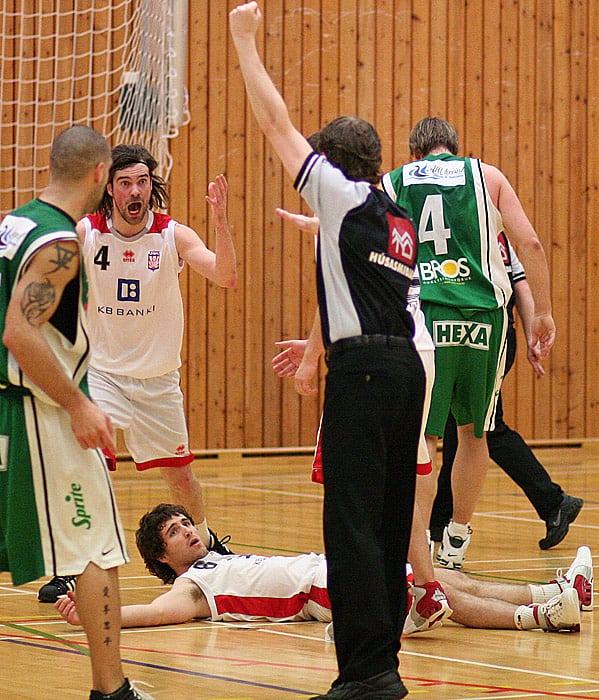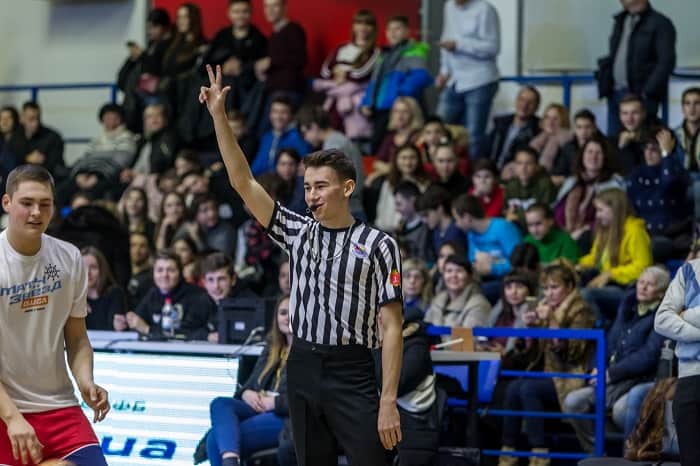- The Jump Manual Review By A Pro Player [Bonus Included] - September 23, 2023
- 3 Best Basketball Shoes For Casual Wear [September 2023] - September 3, 2023
- 5 Best Basketball Shoes For Jumping [September 2023] - August 25, 2023
It was the biggest moment of the game.
The crowd was on their feet, and the tension in the air was palpable. Then the referee’s whistle pierced the air, and everyone in the arena fell silent.
The ref called a reach-in foul on the defender, even though he barely touched the offensive player.
So what is a reach-in foul in basketball? What are the rules surrounding this type of foul, and how can players avoid committing one?
Read on to find out!
Contents
What Is a Reach in Foul in Basketball (Definition)?
A reach-in foul is a specific personal foul where a defensive player illegally extends his arm(s) or legs into the cylinder of an offensive player to steal the ball or disrupt the shot.
This type of foul occurs when a defensive player reaches across the body of an offensive player to swipe at the ball.
The contact must be illegal to be called a reach-in foul. This means that it must occur while the offensive player is in the act of shooting, or it must impede the offensive player’s progress.
Why Does a Reach-In Foul Occur? (Examples)
Reach in fouls occur when a defender makes contact with the ball handler in the following ways:

- Illegally enters the opponent’s space while they are in the process of shooting or dribbling
- Tries to strip the ball away from a player who is dribbling
- Grabs hold of a player to stop them from getting past
- Pushes or bumps a player to steal the ball
- Reaches over the back of a player who is trying to get position for a rebound
Why Do Defenders Reach In for the Ball?
When a defender reaches in for the ball, they try to steal it from the offensive player.
This can be effective if the defender is quick enough to get their hand on the ball before the offensive player thwarts their defensive joust.
Another reason defenders reach in is to prevent the offensive player from getting past them. Extending their arm can dictate the offensive player’s path and force them to change direction.
Finally, a defender reaches for the ball to affect the offensive player’s shot. They can disrupt the shot and give their team a chance to grab the rebound.
Related resource: “What Does PF Mean In Basketball?”
How To Steal the Ball Without Committing a Reach in Foul?
The best way to steal the ball without committing a reach-in foul is to stay patient and wait for the ball handler to make a mistake. This is something that’s totally trainable.
Good defenders will keep their hands up and their feet moving, but they will also be patient and wait for the right opportunity.
As the ball handler dribbles, watch the offensive player’s body language closely – pay special attention to the trunk of their body so you don’t fall victim to any jukes or ball fakes.
Position your body between the ball handler and the basket and always make him go through your chest.
Make your move as soon as the offensive player gets into a vulnerable position. A defender’s speed, quickness, and timing will give them the best chance to steal the ball before they have a chance to react.
Remember, even with incidental contact, you can still get called for a foul! As long as you grab only the basketball, the steal will be clean!
Here’s an explanatory video to help you understand how to play good defense:
What Are the Penalties for Reaching In (With a Reach-in Foul)?
The official will blow the whistle and call a foul, and two scenarios can occur.
If the offensive attacker is in the act of shooting when the illegal contact occurs, they will get three free throws. In addition, if the defensive team is in the bonus penalty situation, the offensive team will also get to shoot free throws.
If the offensive attacker is not shooting when the illegal contact occurs, the attacking team will retain possession of the ball, and the defensive team will be penalized with a foul.
As a related read, check out my epic article on the 6 NBA Divisions.
What Does the NBA Rulebook Say About Reaching In?
While the NBA rulebook does not explicitly use the term “reach-in” foul, it clearly states that a personal foul occurs when a defensive player illegally extends his arm into the personal space of the ball handler.

According to the rulebook, a player is allowed to reach in and try and steal the ball as long as they don’t make contact with the opponent’s body.
If a player does make contact with the opponent’s body as they reach for the ball, it is considered a foul, even if the de
This rule protects the player with the ball and prevents potential injuries if two players collide while reaching for the ball. The injury can be serious if one of the players is landing from a vertical jump, for example.
Why Does The Term Reach In Foul In Basketball Exist if It’s Not Officially In The Rulebook?
The term reach in foul is a very well-known and commonly used term among players, coaches, and officials.
A reach-in foul occurs when a defensive player reaches in and makes contact with the attacker in an attempt to steal the ball. It’s more of a casual term that describes the exact play as they see it.
Reaching in is a very common foul, especially among young and inexperienced players. This is because it can be very difficult to steal the ball without making contact with the body of the ball handler.
As players get older and more experienced, they learn how to steal without committing a reach-in foul
Reach-In Fouls: How Often Are They Called?
There isn’t a specific statistic that tracks the number of reach-in fouls in an NBA game, but they are a prevalent type of foul. In general, personal fouls make up a large portion of the total fouls that are called in an NBA game.
Most teams average 18-20 personal fouls per game in today’s NBA. A good portion of those personal fouls is reach-in fouls.
Can You Reach In at All in Basketball?
In basketball, you can reach in as long as you do not make illegal contact. So, for example, if you reach in and strip only part of the ball, that is completely legal.

The referees will often make a judgment call on whether or not the contact was illegal. If they decide that it was not illegal, the play will continue.
Typically the best defenders focus on moving their feet and staying in front of their man, rather than reaching in.
Related resource: “What Is A Field Goal In Basketball“.
What Are the Fouls in Basketball?

Defensive Fouls
- Holding: Basketball holding is a personal foul in which a defender illegally impedes the progress of an opponent by physical contact or grabbing.
- Hand Check: This type of foul typically occurs when a defender uses their hand to impede the attacker’s movement.
- “Reaching In”: A reach in foul is when a player extends their arm and makes contact with an opposing player.
- Tripping: Tripping is a foul in which a defender impedes the progress of an opponent by causing them to fall or lose their balance. Defenders kick, sweep, or thrust the foot or leg out from under an opponent.
- Elbowing: Elbowing is a foul in which a defender extends their arm and makes contact with an opposing player with their elbow. This contact impedes the opponent’s progress or to gain an advantage in the game. This can also happen on offense when the ball handler throws their elbows out to clear personal space.
- Charging: Charging is a foul in which an offensive attacker runs into a defensive player who has established a position. This usually happens when the attacker is driving to the basket and the defender is trying to take a charge.
- Blocking: Blocking is a foul that can be committed by either an offensive or defensive player. A block is when a player impedes the progress of an opponent with their body.
Offensive Fouls
There are three types of fouls here:
- Pushing Off: Pushing off is a foul in which an attacker uses their hands or arms to push off a defender to create space. This occurs when a player tries to get open for a shot or pass.
- Illegal Screen: An illegal screen is a foul committed by an attacker who setting a screen. A screen is when a player stands in the way of a defender to give their teammate an advantage. An illegal screen is when the screener does not give the defender enough time to avoid the screen, or if the screener sets the screen while holding, blocking, and pushing.
- Charging: Charging is a foul in which an attacker runs into a defensive player who has established position. A charge happens when the attacker is driving aggresively to the basket.
Special Circumstances
- Technical Fouls: Technical fouls are not related to the physical play of the game. Technical fouls can be called for various reasons, such as unsportsmanlike conduct, arguing with the referee, or having too many players on the court.
- Flagrant: Flagrant fouls are the most severe type of foul in basketball. These are fouls with excessive or unnecessary contact, and the infracting defender may receive an ejection from the game.
What Is a Reach-In Foul 2k?
A reach-in foul is the same in NBA 2k as in real life. The foul occurs when the defender makes illegal contact with the ball handler, usually by reaching in with their arm or hand.
This frequently happens in the 2k series video game, so most users try to play passing lanes and intercept a pass.
What Is a Reach Around in Basketball?
There are two types of reach around plays in basketball:

- Reach around pass: This is when a player makes a pass around a defender to a teammate. The attacker passes the ball over the head of the defender or under their arms. Usually, the ball handler will swing his arms out wide and loop the ball around the defender to his teammate.
- Reach around steal: This is when a player reaches around a defender’s body to steal the rock. It’s quite a deceptive move because usually, the stealing happens from behind. The ball handler thinks he beat the defender, but the defender quickly reaches around him and regains possession of the ball.
How Do You Draw a Reach-In Foul?
The best way to draw a reach-in foul is to put pressure on the defender constantly.
If you’re attacking him and he’s off-balance or uncomfortable, he will resort to fouling if he cannot stay in front of you.
Therefore the best way to draw a reach-in foul is to be relentless on offense and put the defender in a difficult position.
FAQ
What Is a Loose Ball Foul?
A loose ball foul is a type of foul that can be committed by either an offensive or defensive player. It occurs when a player makes illegal contact with the ball or another player while the ball is not in possession of either team.
What Happens After a Reach-in Foul?
After a reach-in foul is called, the team that was fouled gets the ball out of bounds on the sideline or baseline nearest to where the foul occurred. If the fouling team is in the bonus, the fouled team gets a “one and one” free throw attempt. If the fouling team is in the double bonus, the fouled team gets to attempt two free throws.
Reach-in Foul vs Steal?
A reach-in foul is when a defender illegally contacts a ball handler, usually by reaching in with their arm or hand. A steal is when a player takes the ball from another player without fouling them. If they dispossess the opponent cleanly, no foul will be called.
What Is the Reach-in Foul Signal?
The reach-in foul signal is when the referee raises one arm in a fist and then grabs his wrist with the opposite arm.

